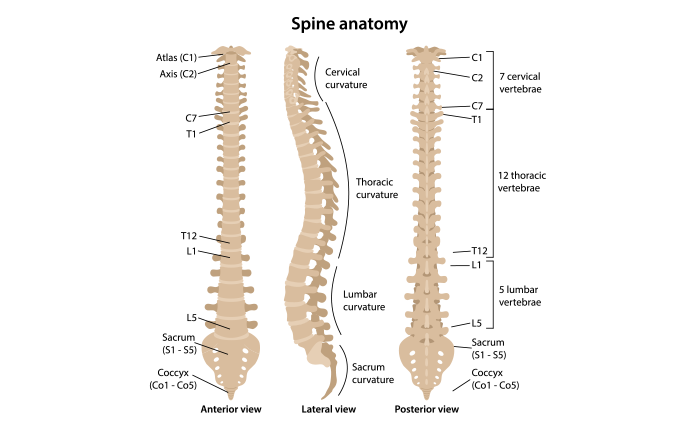Your spine is unlike any other part of your body. It is an incredibly complex series of bones, joints and other tissues. The spine is composed of 33 bones, called vertebrae, divided into five sections. These bones make up the spinal column that holds your body upright, allows it to twist and bend and provides a safe channel for nerves to run from the brain throughout your body. Understanding the parts of the spine can give you a better idea of what to look out for when it comes to pain or injury. Here, we break down the main parts of the spine.
What exactly is the spine?
The spine is a column of bones that work together to house the spinal cord, our nervous system’s “superhighway.” Messages travel from the brain, down the spine and out through the peripheral nerves, think smaller highways and city streets. Unfortunately, spinal injuries may result in some messages never reaching their destination.
Discs between the vertebrae act as cushions to prevent bones from grinding against each other. These are the discs that can be bulging, herniated or thinning. They naturally get thinner as we age and cause us to lose height, and make us more susceptible to injury.
What are the five main parts of the spine?
The parts of the spine are broken into these five sections of vertebrae:
Cervical spine (neck)
Seven cervical vertebrae (C1-C7) make up the cervical spine section. The aptly-named “atlas vertebra” supports the skull, similar to how the mythological Atlas holds up the world. The cervical spine has the greatest range of motion of all the sections. C1 and C2 allow us to turn, tilt, nod and pivot our heads.
Thoracic spine (middle back)
This section consists of 12 vertebrae (T1-T12) that connect to ribs and protect the heart and lungs as its primary function. Each of the 12 pairs of ribs connects to one of the 12 thoracic vertebrae.
Pain in this area usually lasts only a short time and isn’t known to be particularly painful. However, the causes of the pain do tend to be more severe than causes for pain in the cervical or lumbar sections.
Lumbar spine (lower back)
The lumbar vertebrae (L1-L5) serve to support the neck and thoracic regions. These are the largest of the vertebrae, and they excel at absorbing stresses from lifting and carrying loads. Together, they create a slight outward curve to the spinal column in contrast to the inward curve of the thoracic section.
Most spinal column issues are in the lumbar section because of the weight the lumbar spine carries. Injuries from L3-L5 affect both the legs and hips, and they may also lead to numbness in the feet.
Sacrum
Below the lumbar spine is the sacrum, a triangular bone of five fused vertebrae (S1-S5). They connect to the hips on the left and right to create a circular structure called the pelvic girdle.
It is highly durable by necessity; multiple key muscle groups attach to the sacrum. The sacrum bears the weight of the upper body and is integral to walking and other leg functions. Issues with the sacrum will impair your ability to walk, sit and stand.
Coccyx
Like the sacrum, the coccyx is a highly durable, weight-bearing structure. The coccyx’s main job is to serve as an attachment site for muscle insertion. These muscles aid in defecation, support for female reproductive organs and help you move your legs. The coccyx also provides a third point of contact when a person sits down.
What are some of the tissues that make up the spine?
Other than the discs, here are a couple of other tissues that are also parts of the spine:
Spinal Cord
The spinal cord is a dense mass of nerves and tissue that runs from the brain to the lower back. Together with the brain, it makes up the central nervous system. The three layers, known as meninges, that protect the spinal cord are called dura mater, arachnoid mater and pia mater. Between the dura mater and arachnoid mater is the epidural space, an area where anesthesiologists may apply anesthetics during childbirth.
Facet Joints
Facet joints connect one vertebra to another and allow the neck and back to move forward and backward. They are, unfortunately, also a common cause of pain in the spine, particularly in the lumbar section. This is because the lumbar section sees the most significant amounts of strain. In addition, the cervical and thoracic regions have facet joints that can cause chronic pain.
Spine doctors in Cary and Raleigh
The spine is a critical part of the body and is far more complex than most people realize. Maintaining its health is essential for those looking to achieve the highest quality of life, regardless of age. A healthy spine will enable you to be physically active for decades to come.
Cary Orthopaedics Spine Center is the Triangle’s only comprehensive spine practice. Comprehensive means expert specialists all under one roof, working together to reduce back pain and restore function with a wide range of treatments. From non-invasive options to complex back surgery to spine-specific physical therapy, Cary Orthopaedics Spine Center offers everything to get those suffering from back pain back in motion. Learn more about our spine center on our spine center homepage, or contact us today for an appointment.






